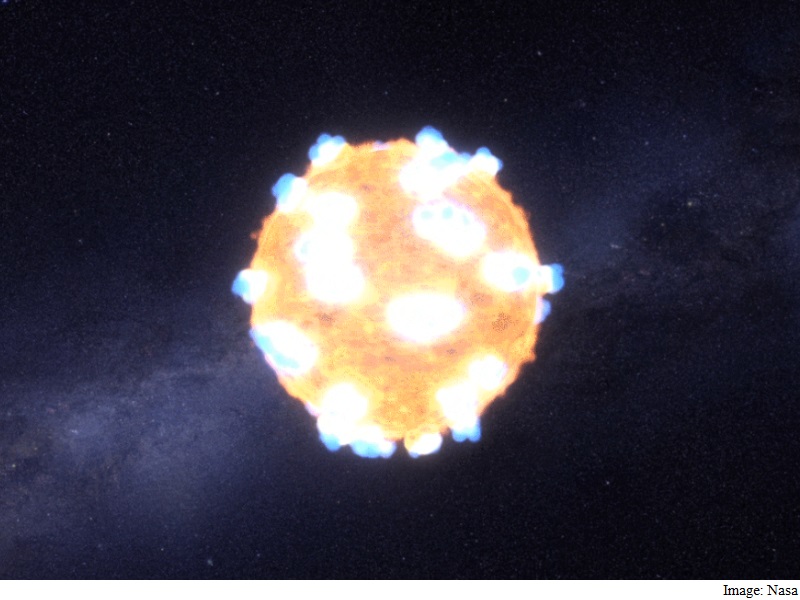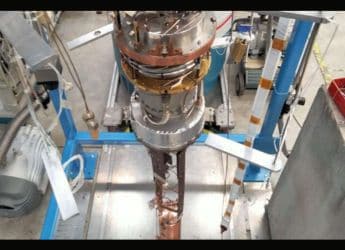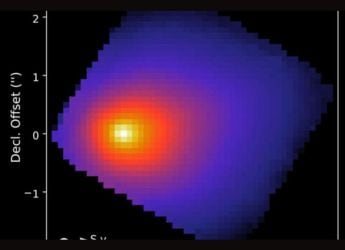- Home
- Science
- Science News
- Supernova Shockwave Captured in Visible Light for First Time
Supernova Shockwave Captured in Visible Light for First Time

The team led by Peter Garnavich, astrophysics professor at the University of Notre Dame in Indiana, analysed light captured by Kepler every 30 minutes over a three-year period from 500 distant galaxies, searching some 50 trillion stars.
They were hunting for signs of massive stellar death explosions known as supernovae.
For the first time, a supernova shockwave has been observed in the optical wavelength or visible light as it reaches the surface of the star.
This early flash of light is called a "shock breakout".
The explosive death of this star, called KSN 2011d, as it reaches its maximum brightness takes 14 days.
The shock breakout itself lasts only about 20 minutes, so catching the flash of energy is an investigative milestone for astronomers.
In 2011, two of these massive stars, called red supergiants, exploded while in Kepler's view.
The first behemoth, KSN 2011a, is nearly 300 times the size of our sun and a mere 700 million light years from Earth.
The second, KSN 2011d, is roughly 500 times the size of our sun and around 1.2 billion light years away.
"To put their size into perspective, Earth's orbit about our sun would fit comfortably within these colossal stars," said Garnavich.
The "shock breakout" itself lasts only about 20 minutes, so catching the flash of energy is an investigative milestone for astronomers.
"In order to see something that happens on timescales of minutes, like a shock breakout, you want to have a camera continuously monitoring the sky," Garnavich added.
Supernovae like these - known as Type II - begin when the internal furnace of a star runs out of nuclear fuel causing its core to collapse as gravity takes over.
The two supernovae matched up well with mathematical models of Type II explosions reinforcing existing theories. But they also revealed what could turn out to be an unexpected variety in the individual details of these cataclysmic stellar events.
Understanding the physics of these violent events allows scientists to better understand how the seeds of chemical complexity and life itself have been scattered in space and time in our Milky Way galaxy
"All heavy elements in the universe come from supernova explosions. For example, all the silver, nickel, and copper in the earth and even in our bodies came from the explosive death throes of stars," explained Steve Howell, project scientist for Nasa's Kepler and K2 missions.
The research paper reporting this discovery has been accepted for publication in the Astrophysical Journal.
Catch the latest from the Consumer Electronics Show on Gadgets 360, at our CES 2026 hub.
- Samsung Galaxy Unpacked 2025
- ChatGPT
- Redmi Note 14 Pro+
- iPhone 16
- Apple Vision Pro
- Oneplus 12
- OnePlus Nord CE 3 Lite 5G
- iPhone 13
- Xiaomi 14 Pro
- Oppo Find N3
- Tecno Spark Go (2023)
- Realme V30
- Best Phones Under 25000
- Samsung Galaxy S24 Series
- Cryptocurrency
- iQoo 12
- Samsung Galaxy S24 Ultra
- Giottus
- Samsung Galaxy Z Flip 5
- Apple 'Scary Fast'
- Housefull 5
- GoPro Hero 12 Black Review
- Invincible Season 2
- JioGlass
- HD Ready TV
- Laptop Under 50000
- Smartwatch Under 10000
- Latest Mobile Phones
- Compare Phones
- OPPO Reno 15 Pro Max
- Honor Win RT
- Honor Win
- Xiaomi 17 Ultra Leica Edition
- Xiaomi 17 Ultra
- Huawei Nova 15
- Huawei Nova 15 Pro
- Huawei Nova 15 Ultra
- Asus ProArt P16
- MacBook Pro 14-inch (M5, 2025)
- OPPO Pad Air 5
- Huawei MatePad 11.5 (2026)
- Xiaomi Watch 5
- Huawei Watch 10th Anniversary Edition
- Acerpure Nitro Z Series 100-inch QLED TV
- Samsung 43 Inch LED Ultra HD (4K) Smart TV (UA43UE81AFULXL)
- Asus ROG Ally
- Nintendo Switch Lite
- Haier 1.6 Ton 5 Star Inverter Split AC (HSU19G-MZAID5BN-INV)
- Haier 1.6 Ton 5 Star Inverter Split AC (HSU19G-MZAIM5BN-INV)












